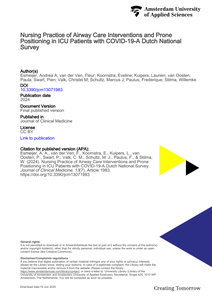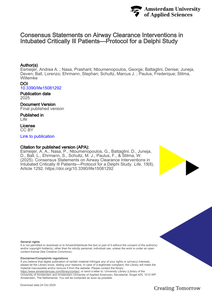Background: Airway care interventions and prone positioning are used in critically ill patients with coronavirus disease 2019 (COVID-19) admitted to the intensive care unit (ICU) to improve oxygenation and facilitate mucus removal. At the onset of the COVID-19 pandemic, the decision-making process regarding the practice of airway care interventions and prone positioning was challenging. Objective: To provide an overview of the practice of airway care interventions and prone positioning during the second wave of the pandemic in the Netherlands. Method: Web-based survey design. Seventy ICU nurses, each representing one intensive care in the Netherlands, were contacted for participation. Potential items were generated based on a literature search and formulated by a multidisciplinary team. Questions were pilot tested for face and construct validity by four intensive care nurses from four different hospitals. Results: The response rate was 53/77 (69%). This survey revealed widespread use of airway care interventions in the Netherlands in COVID-19 patients, despite questionable benefits. Additionally, prone positioning was used in invasively and non-invasively ventilated patients. Conclusions: The use of airway care interventions and prone positioning is time consuming and comes with the production of waste. Further research is needed to assess the effectiveness, workload, and environmental impact of airway care interventions and prone positioning.
DOCUMENT

Intubated critically ill patients are susceptible to secretion accumulation because of compromised airway clearance. Various airway clearance interventions are employed to prevent complications arising from mucus retention. This Delphi study aims to collect global opinions in an international expert panel of ICU professionals on the usefulness of these various airway clearance interventions. A steering committee performed a literature search informing the formulation of statements. Statements are grouped into two distinct parts: (1) Humidification and Nebulization, and (2) Suctioning and Mucus mobilization techniques. For each part, a diverse panel of 30–40 experts will be selected, with concerted effort to involve experts from various medical specialties involved in airway clearance methods. Multiple choice questions (MCQs) or 7-point Likert-scale statements will be used in the iterative Delphi rounds to reach consensus on various airway clearance interventions. Rounds will continue until stability is achieved for all statements. Consensus will be deemed achieved when a choice in MCQs or a Likert-scale statement achieves ≥75% agreement or disagreement. Starting from the second round of the Delphi process, stability will be assessed using non-parametric χ2 tests or Kruskal–Wallis tests. Stability will be defined by a p-value of ≥0.05.
DOCUMENT

BACKGROUND: Chest physiotherapy is widely prescribed to assist the clearance of airway secretions in people with cystic fibrosis (CF). Positive expiratory pressure (PEP) devices provide constant back pressure to the airways during expiration. This may improve clearance by building up gas behind mucus via collateral ventilation. Given the widespread use of PEP devices, there is a need to determine the evidence for their effect.OBJECTIVES: To determine the effectiveness and acceptability of PEP devices compared to other forms of physiotherapy as a means of improving mucus clearance and other outcomes in people with CF.SEARCH STRATEGY: We searched the Cochrane Cystic Fibrosis and Genetic Disorders Group Trials Register comprising of references identified from comprehensive electronic database searches and handsearches of relevant journals and abstract books of conference proceedings. The electronic database CINAHL was also searched from 1982 to 2001. Most recent search of the Group's register: February 2006.SELECTION CRITERIA: Randomised controlled studies in which PEP was compared with any other form of physiotherapy in people with CF.DATA COLLECTION AND ANALYSIS: Two authors independently applied the inclusion and exclusion criteria to publications and assessed the quality of the included studies.MAIN RESULTS: Forty studies were identified and twenty-five studies involving 507 participants met the review inclusion criteria. Most included studies had low scores on a scale of study quality. Twenty of these studies involving 300 participants were cross-over in design. Data were not published in sufficient detail in most of these studies to perform meta-analysis.Forced expiratory volume in one second (FEV1) was the most frequently measured outcome. Single interventions or series of treatments continued for up to three months demonstrated no significant difference in effect between PEP and other methods of airway clearance on FEV1. Long-term studies had equivocal or conflicting results regarding the effect on FEV1. Participant preference was reported in nine studies. In all studies with an intervention period of at least one month, measures of participant preference were in favour of PEP. The results for the remaining outcome measures were not examined or reported in sufficient detail to provide any high level evidence.AUTHORS' CONCLUSIONS: There was no clear evidence that PEP was a more or less effective intervention overall than other forms of physiotherapy. There was limited evidence that PEP was preferred by participants compared to other techniques, but this finding is from studies of low quality.
DOCUMENT